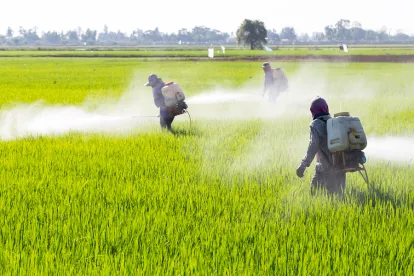On June 3, 2020, the U.S. Court of Appeals for the Ninth Circuit (Ninth Circuit) issued an opinion in National Family Farm Coalition v. EPA, No. 19-70115, vacating the U.S. Environmental Protection Agency’s (EPA) 2018 decisions to extend the conditional registrations for three reduced volatility dicamba herbicides, Bayer’s XtendiMax, Corteva’s FeXapan, and BASF’s Engenia.
The manufacturers of these dicamba products designed them to facilitate control of glyphosate resistant weeds in strains of soybeans and cotton that have been genetically modified to be dicamba tolerant (DT). Although the manufacturers intended these dicamba products to be less volatile and less susceptible to drift into adjacent non-target areas than previous formulations of dicamba, there were nonetheless many complaints that the products cause damage to non-tolerant crops and other vulnerable vegetation. The Petitioners that challenged EPA’s decision to extend the conditional registrations for these reformulated dicamba products include a group representing small farmers who claim that the new dicamba products have damaged their crops (National Family Farm Coalition) and several non-governmental organizations that routinely oppose new pesticide registrations (the Center for Food Safety, the Center for Biological Diversity, and Pesticide Action Network North America).
Although the case included some allegations by the Petitioners that EPA did not comply with the requirements of the Endangered Species Act, the court did not reach those issues. The court found unanimously that EPA’s decision to extend the conditional registrations for the three dicamba herbicides did not satisfy the requirements of the Federal Insecticide, Fungicide, and Rodenticide Act (FIFRA). Specifically, the court found that the administrative record compiled by EPA did not include “substantial evidence” supporting EPA’s determination that registering the new uses “would not significantly increase the risk of any unreasonable adverse effects on the environment.” EPA is required under FIFRA Section 3(c)(7)(B) to make this determination to grant a conditional registration of new uses of a currently registered pesticide. The court concluded that EPA could not make this required determination because, the court stated, the record shows that EPA “substantially understated the risks that it acknowledged” and also “entirely failed to acknowledge other risks.”
According to the court, EPA made six material errors in its analysis supporting the registrations. First, the court stated that EPA understated the amount of acreage planted with DT crops in 2018, and consequently also underestimated the amount of the new dicamba products that would be applied that year, even though the decision to extend the conditional registrations for the new dicamba products was not issued until the end of the 2018 growing season. Second, in the court’s view, EPA improperly found that the number of complaints concerning damage to non-target crops and vegetation by the new dicamba products might be over-reported when the record included overwhelming evidence that non-target damage was being under-reported. Third, the court stated that EPA refused even to estimate how much damage to non-target vegetation would be caused by the new dicamba products when the record contained sufficient information for EPA to make such an estimate. Fourth, according to the court, EPA refused to acknowledge the substantial risk of non-compliance with the large number of detailed restrictions set forth in the 40-page approved label, although the court found that “there was substantial evidence that even conscientious applicators had not been able to consistently adhere to the label requirements.” Fifth, the court believes EPA failed to acknowledge the anti-competitive effect of the new technology, which encourages other growers to use DT crops even if they do not use the new dicamba products, to avoid damage from nearby applications. Sixth, according to the court, EPA failed to acknowledge the social cost being caused in small communities where damage caused by use of the new dicamba products has turned formerly amicable neighbors against each other.
Based on all of these purported deficiencies, the court held that EPA’s rationale for determining that the risk of unreasonable adverse effects would not be significantly increased by the new dicamba uses, and that the registration for the new dicamba products could therefore be extended for two additional years, was not supported by “substantial evidence” in the administrative record taken as a whole. The court also held that remanding the matter to EPA for further action without vacatur would not be appropriate because EPA did not satisfy the requirement to extend the conditional registrations. Instead, the court simply vacated the registrations and invited EPA to try again. The court acknowledged that such a decision would cause disruption, especially for those growers that have already purchased DT seeds and dicamba herbicides for this year's growing season, but concluded that no remedy other than vacatur would be appropriate given the deficiencies in the administrative record.
Commentary
When FIFRA was amended to allow new pesticide products to be “conditionally” registered even though the applicants had not submitted data to satisfy all applicable requirements, the focus was primarily on allowing registration of new products that are “substantially similar” to already registered products. FIFRA Section 3(c)(7) also allows conditional registrations to be issued for new uses of existing active ingredients and for new active ingredients without all required data if EPA has sufficient information to make certain findings while it waits for additional data, but requires that EPA be able to determine that certain requirements can be met even though not all of the supporting data that will ultimately be needed are yet available.
This court’s decision illustrates the type of problems that can occur when EPA issues a conditional registration for new products that are not “substantially similar” to registered products. The court’s view of the sufficiency of the record in this case sets a high bar for the determinations that must support other types of conditional registrations. This problem was previously illustrated when a reviewing court vacated a new registration for a new nanosilver product even though there were already registered nanosilver products. In that case, because EPA chose as a matter of policy to characterize the product as a new active ingredient, it was required to make a “public interest” determination under FIFRA Section 3(c)(7)(C). When the administrative record was deemed insufficient to support this mandatory determination, the reviewing court vacated the registration.
In the case of the new dicamba products, to grant conditional registrations for new uses of an existing active ingredient, EPA was required to determine that the new uses on DT soybeans and cotton would not “significantly increase the risk of unreasonable adverse effects on the environment” under FIFRA Section 3(c)(7)(B). The court found the record supporting this mandatory determination to be insufficient, resulting in the court’s vacatur of EPA’s decision. These two reviewing courts have taken a relatively deep dive into the administrative record supporting a conditional registration for a new use of an existing active ingredient or a new active ingredient in evaluating whether substantial evidence in the record supports the determinations required by FIFRA. Whether future decisions will maintain such a stringent evidentiary standard will be important to monitor.




 />i
/>i

